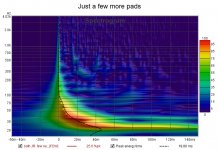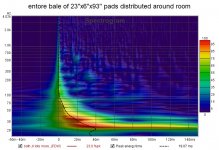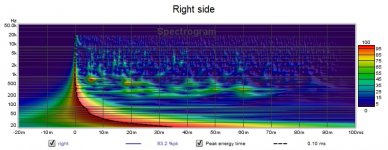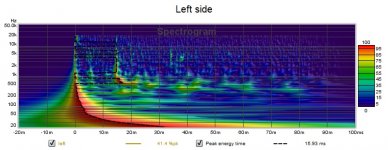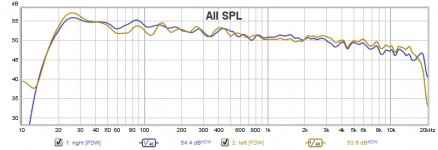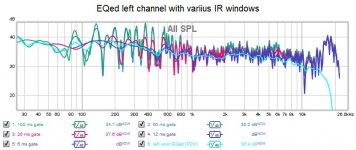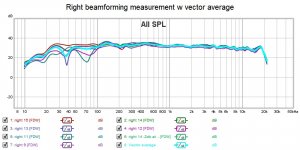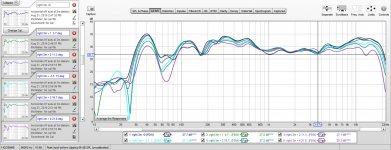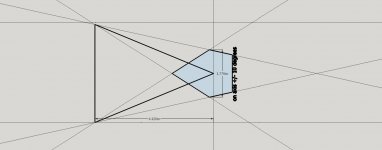How should I be spending my time? I thought it was best to tame the room before doing anything else so I bought a bale of 9 6.5" thick fiberglass batts 23"x93". My plan was to build conventional absorber panes. After building the first one, I just started folding batts in half paper side out and stuffing them on shelves around the room. Spectrograms (un-normalized) show marked improvement:
Here is how it looked before I started:
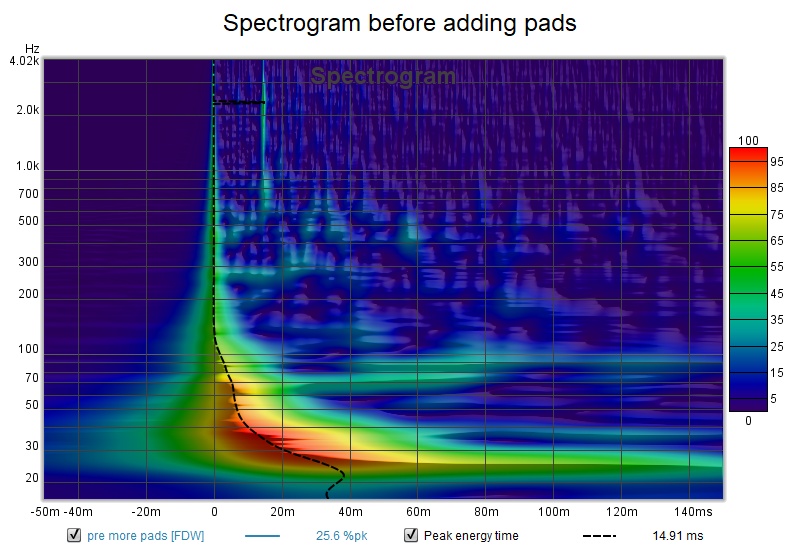
Here is after a tentative first step with just 4 of the 9 batts in place
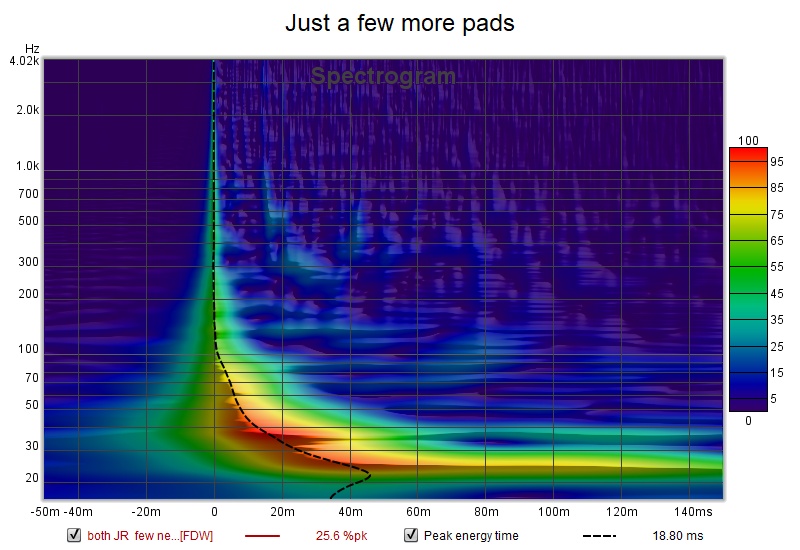
and finally with all 9 batts in place mostly on the back wall
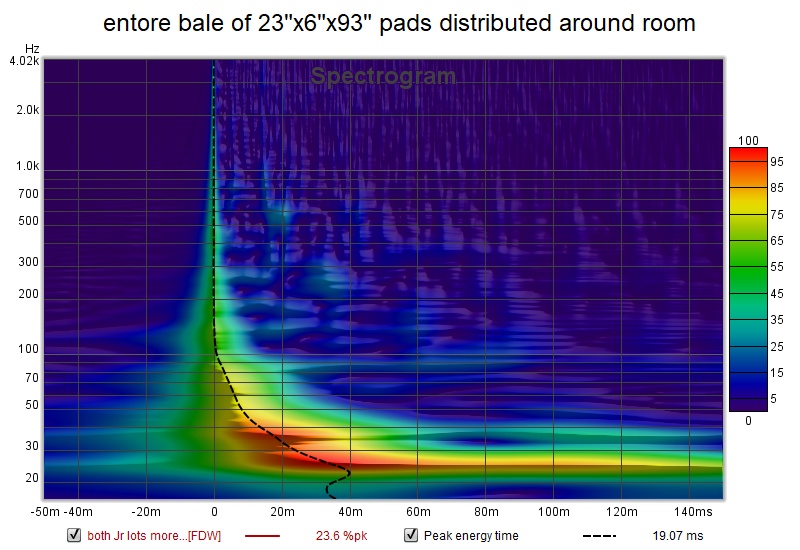
Amazing what one roll or bale can do. Now to pretty and finalize the installation. But before that a re-eq to take advantage of the improvements
Here is how it looked before I started:
Here is after a tentative first step with just 4 of the 9 batts in place
and finally with all 9 batts in place mostly on the back wall
Amazing what one roll or bale can do. Now to pretty and finalize the installation. But before that a re-eq to take advantage of the improvements
Attachments
Nice work!
You are doing exactly the right thing imo/ime....solving acoustic problems acoustically.
I wish everyone spent more time separating speaker tuning from room tuning.
Gives greatly superior results than lumping them into one tuning basket, ....again imo/ime.
You are doing exactly the right thing imo/ime....solving acoustic problems acoustically.
I wish everyone spent more time separating speaker tuning from room tuning.
Gives greatly superior results than lumping them into one tuning basket, ....again imo/ime.
funny how that works. suppressed more of the room and now I get to a listenable eq with fewer PEQs. didn't even need FIR or auto EQ.
but I also found I'm not done yet. I still have some sub 10 ms reflections to track down. They don't show up in the spectrum of both sides playing together but you can see the effects in the individual speaker responses.
also the echos die out in under 200 ms now vs 500 ms or so before
but I also found I'm not done yet. I still have some sub 10 ms reflections to track down. They don't show up in the spectrum of both sides playing together but you can see the effects in the individual speaker responses.
also the echos die out in under 200 ms now vs 500 ms or so before
I don't have the ears to do a detailed critique but its getting there. Some tracks are really striking. Above 1 khz seems to be free of the room and with the right taper sounds really good. I think I've got the bass level about right this time. The imaging is good but I think will improve with more room treatment.
Try some DSP on what you have right now, just to get a taste. It is a game changer...
You've got reasonable clean output up to 15 ms, the DRC will help focus it. I've got your back, I'm home again.
You've got reasonable clean output up to 15 ms, the DRC will help focus it. I've got your back, I'm home again.
Well, a couple of days without working on FIR/DSP but I did make another absorber panel and re-arrange some of my loose fiberglass batts for a small reduction in not very late reflections.
I also posted in REW forum about possible issues in REW export process.
Export, Import and Compare | AV NIRVANA
which might explain my difficulties with DRC.
But it also brings up question as to what I should correct manually. By playing with time gates in IR windows of REW, I see that my FR ripples around 200 Hz are due to reflections arriving at delays of 8-12 ms. FDW5, which I have been using for manual EQ, doesn't exclude them. Most of my effort last couple of days has been to try and eliminate them.
I also posted in REW forum about possible issues in REW export process.
Export, Import and Compare | AV NIRVANA
which might explain my difficulties with DRC.
But it also brings up question as to what I should correct manually. By playing with time gates in IR windows of REW, I see that my FR ripples around 200 Hz are due to reflections arriving at delays of 8-12 ms. FDW5, which I have been using for manual EQ, doesn't exclude them. Most of my effort last couple of days has been to try and eliminate them.
Well, a couple of days without working on FIR/DSP but I did make another absorber panel and re-arrange some of my loose fiberglass batts for a small reduction in not very late reflections.
I also posted in REW forum about possible issues in REW export process.
Export, Import and Compare | AV NIRVANA
which might explain my difficulties with DRC.
But it also brings up question as to what I should correct manually. By playing with time gates in IR windows of REW, I see that my FR ripples around 200 Hz are due to reflections arriving at delays of 8-12 ms. FDW5, which I have been using for manual EQ, doesn't exclude them. Most of my effort last couple of days has been to try and eliminate them.
John showed that if exports and imports have the same cal files and IR windows, they look the same. The difficulty is in arranging that. I have been applying an FDW5 by default in all my measurements. The problem is when that is removed, a 1/48th octave smoothing remains. This is what was causing most of the difference. But also when you import a WAV exported from a measurement, you have to re-apply any CAL files that were used - which as far as I can tell means importing the cal files into the MDAT and doing trace arithmetic.
Not sure why you mention exporting to text? You want to export the IR as a wav file with no smoothing or any FDW applied then use Audacity or something else to do the pcm 32 bit float conversion. By exporting with REW to a wav file you should have the IR at the 1 second mark if not you may need to tell DRC where the impulse centre is. DRC uses it's own mic cal file so you don't want to have that embedded in the exported wav file.
Exporting text mentioned just for completeness. Text is the one export that the calibration files don't have to follow.
I export as WAV and convert to PCM for DRC in SOX. Was re-importing to REW to verify correctness of the SOX output. It was the 1/48th octave smoothing that REW applies on removing an FDW that was making me question SOX. But it looks like SOX is fine which is nice because unlike Audacity it can be scripted.
But now I have to look for another reason why DRC doesn't seem to work for me. I'll start with new measurements that don't have an FDW by default and do my manual EQ with something like ERB smoothing that filters out those reflection induced ripples in the midrange, leaving them to DRC to deal with.
I export as WAV and convert to PCM for DRC in SOX. Was re-importing to REW to verify correctness of the SOX output. It was the 1/48th octave smoothing that REW applies on removing an FDW that was making me question SOX. But it looks like SOX is fine which is nice because unlike Audacity it can be scripted.
But now I have to look for another reason why DRC doesn't seem to work for me. I'll start with new measurements that don't have an FDW by default and do my manual EQ with something like ERB smoothing that filters out those reflection induced ripples in the midrange, leaving them to DRC to deal with.
You want your DRC measurement to be a clean as possible no FDW added. DRC is working on it's own FDW and if you have applied a different one in a base measurement it is unlikely to produce the expected results. Some form of pre eq is useful to allow DRC to produce the best results if the base measurement is a long way from the target response. You can do that virtually by using REW EQ and exporting the filters to an impulse and convolving it with your measurement, you can then convolve the REW EQ with the correction filter to get back to the same point.
Try using a flat target for testing as it will be easier to so where it deviates.
Try using a flat target for testing as it will be easier to so where it deviates.
Its time to bring this thread back to life. Things went on hold when my mic and soundcard started misbehaving bringing my results into question. Somewhere along the line, I had lost about 40 db of sensitivity but the relative SPL staid the same so I kept on using the equipment. Then I noticed the tip of the mic was askew and when I went to inspect it, I broke wires necessitating a new mic. The soundcard issues may be the driver or the OS, there have been a number of audio glitches reported recently due to Windows updates. I had been using the Java driver. Switching to ASIO driver temporarily fixed the senstivity issue but ASIO wouldn't run at 96 khz sample rate. When I re-installed the drivers, it wouldn't run at all using ASIO. So I got a new sound card - a Motu Ultralite MkIV. 10 analog outputs from 32-bit Sabre DACs and a driver that lets me reach them all from Windows and JRiver.
But I can't use this new equipment just yet as I had a medical procedure earlier this week and have to take it easy for another little while. I can sit here and post some hopefully interesting results from the last couple of weeks.
But I can't use this new equipment just yet as I had a medical procedure earlier this week and have to take it easy for another little while. I can sit here and post some hopefully interesting results from the last couple of weeks.
fluid had prompted me to try beamforming measurements some time ago. I knew he was right and so eventually I did. I took a series of measurements at 1 foot intervals along a line from my primary LP to the center of the array. This was with my miniDSP manual EQ but no FIR.
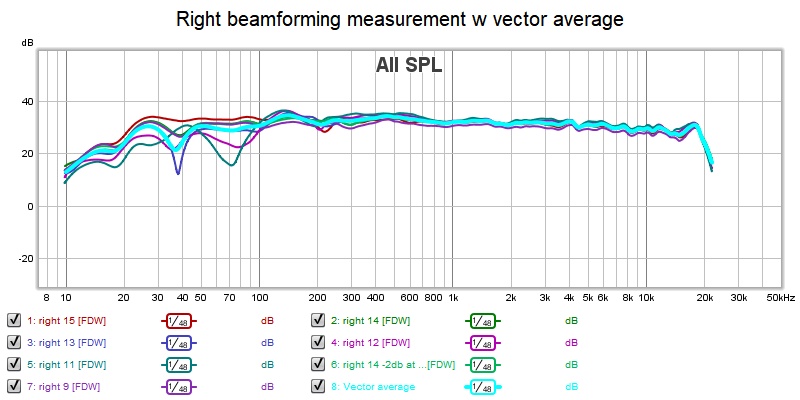
I have flat bass below 100 Hz at the primary LP which isn't surprising since that is how I equalized it. As I move in towards the array, room effects increasingly show up. They are the greatest below 100 Hz and taper off in the 100-1000 Hz region.
Its striking how highly correlated the diverse measurements are above 1 khz. This suggests I can do a fine grained equaliztion in this region at least along this line. That needs to be confirmed by measurements at other angles.
Apologies for the 20 db scale of the drawing. REW's choice, not mine.
I have flat bass below 100 Hz at the primary LP which isn't surprising since that is how I equalized it. As I move in towards the array, room effects increasingly show up. They are the greatest below 100 Hz and taper off in the 100-1000 Hz region.
Its striking how highly correlated the diverse measurements are above 1 khz. This suggests I can do a fine grained equaliztion in this region at least along this line. That needs to be confirmed by measurements at other angles.
Apologies for the 20 db scale of the drawing. REW's choice, not mine.
Attachments
For completeness, I should post the left.
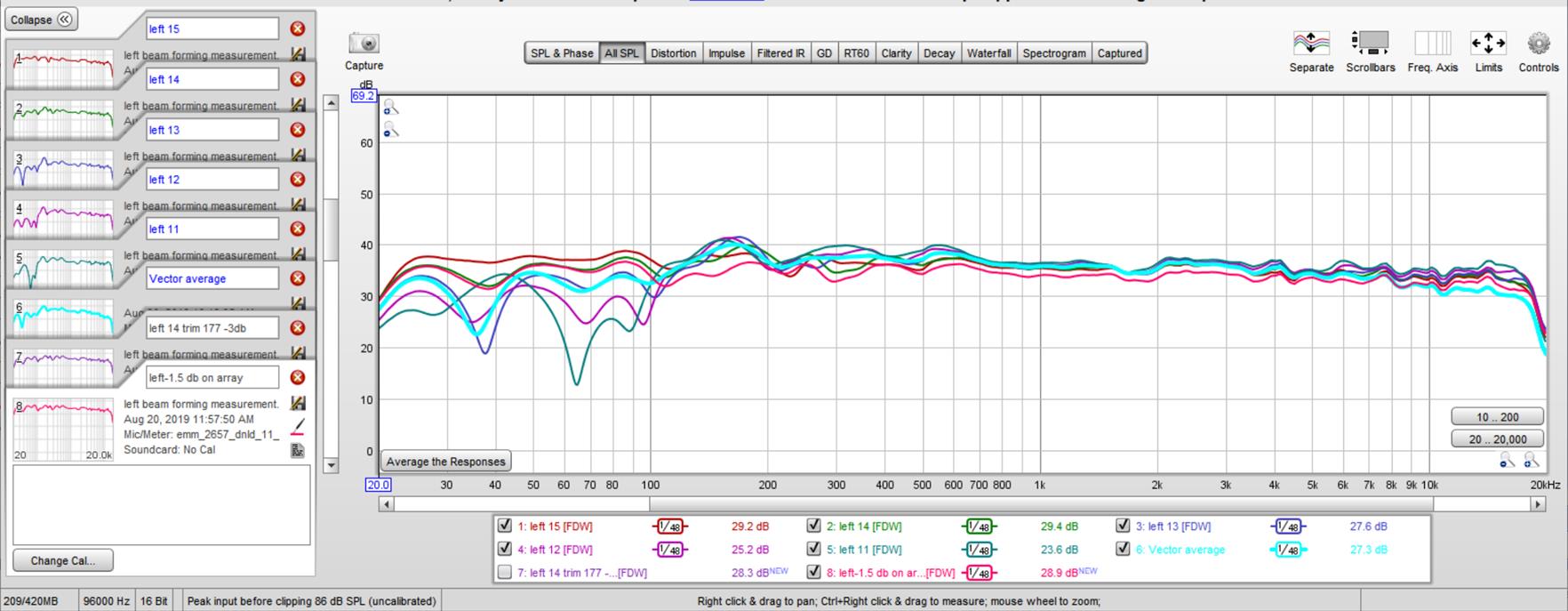
This channel has more room in it. The spectrogram shows a 15 ms delayed reflection affecting 100 to 1000 Hz. With that delay, I don't want to over react to it. But, as you can see in the bottom two measurements I increased the attenuation I already had on the peak at 177 hz and I dropped the level of the array by 1.5 db. This is what I'm listening to now.
This channel has more room in it. The spectrogram shows a 15 ms delayed reflection affecting 100 to 1000 Hz. With that delay, I don't want to over react to it. But, as you can see in the bottom two measurements I increased the attenuation I already had on the peak at 177 hz and I dropped the level of the array by 1.5 db. This is what I'm listening to now.
Attachments
The horizontal off axis measurement had a number of things to tell me. I took this data at 3m distance from the right array, on its axis and then moved to the right in 1 foot steps, about 5.7 degrees per step. This put me well out into the room.
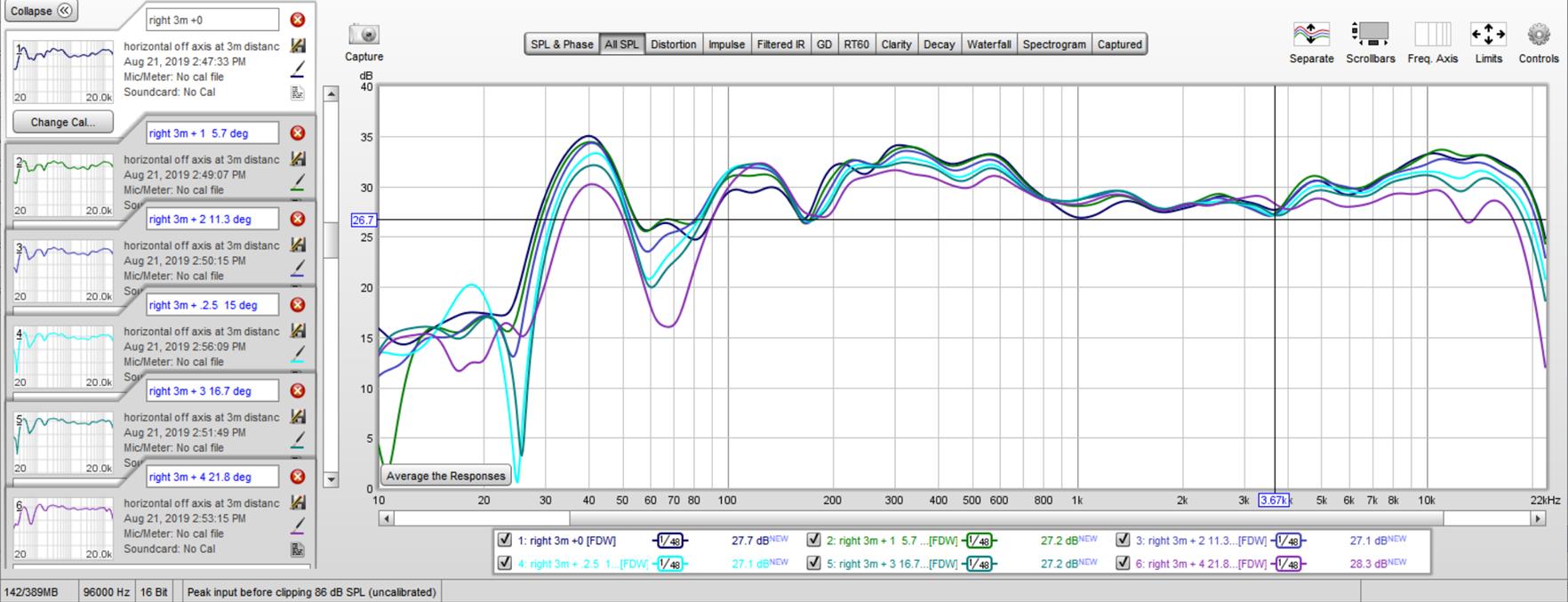
A different bass equalization is needed in this region. I wonder if more woofers would help. I have them to deploy.
I see the PEQ attenuation I have at 177 Hz hurts the response out there in the room to almost the same extent it helps closer to the wall.
Above about 7 khz, I see the treble falling off per the dispersion characteristics of the driver. Response can be equalized nicely flat within a +/- 11 degree off axis listening window. Outside that window it falls off rapidly. I need to point the arrays at the primary LP and re-equalize.
This will give me this listening triangle with flat HF response over an almost 6' wide area. (pity my hearing won't allow me to appreciate it fully)
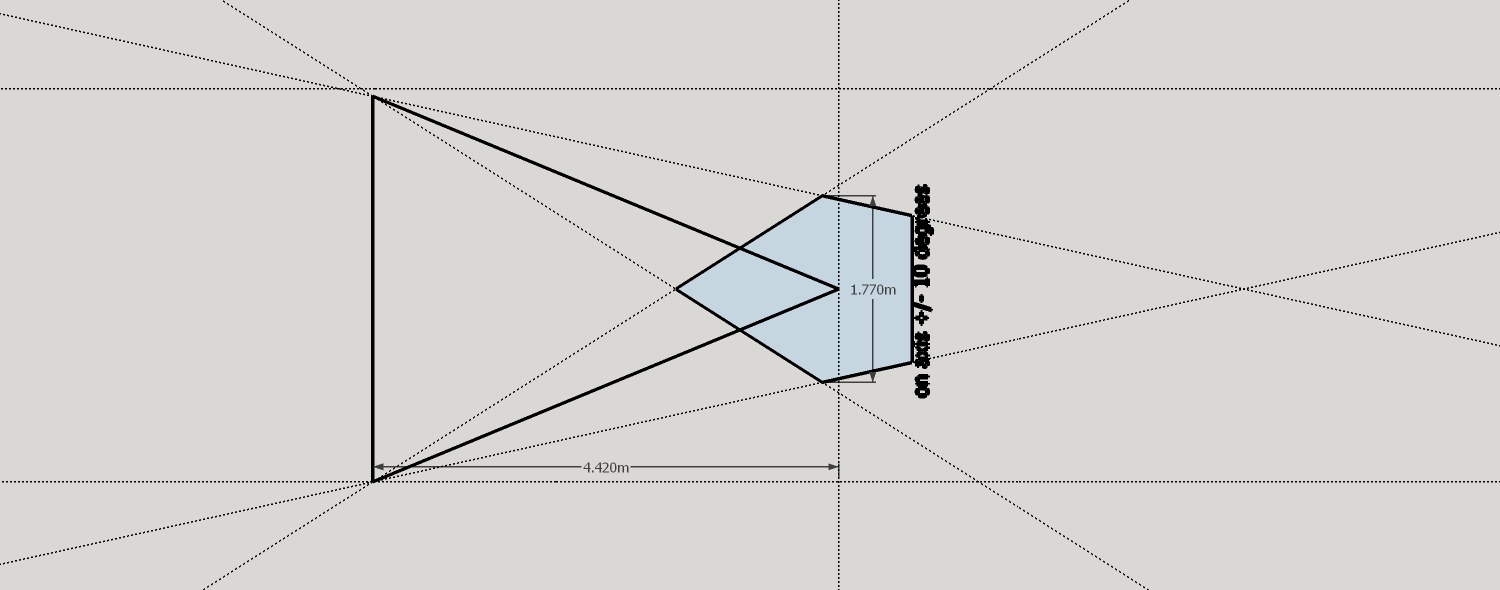
(blue polygon is within +/- 10 degrees of on axis)
A different bass equalization is needed in this region. I wonder if more woofers would help. I have them to deploy.
I see the PEQ attenuation I have at 177 Hz hurts the response out there in the room to almost the same extent it helps closer to the wall.
Above about 7 khz, I see the treble falling off per the dispersion characteristics of the driver. Response can be equalized nicely flat within a +/- 11 degree off axis listening window. Outside that window it falls off rapidly. I need to point the arrays at the primary LP and re-equalize.
This will give me this listening triangle with flat HF response over an almost 6' wide area. (pity my hearing won't allow me to appreciate it fully)
(blue polygon is within +/- 10 degrees of on axis)
Attachments
Last edited:
The multi sub optimizer software seems to do good job of finding solutions to even the bass across an area if have a few subs to try with it, you have enough channels on your soundcard now to make it work.
- Home
- Loudspeakers
- Full Range
- Full range line array for wall or corner placement

